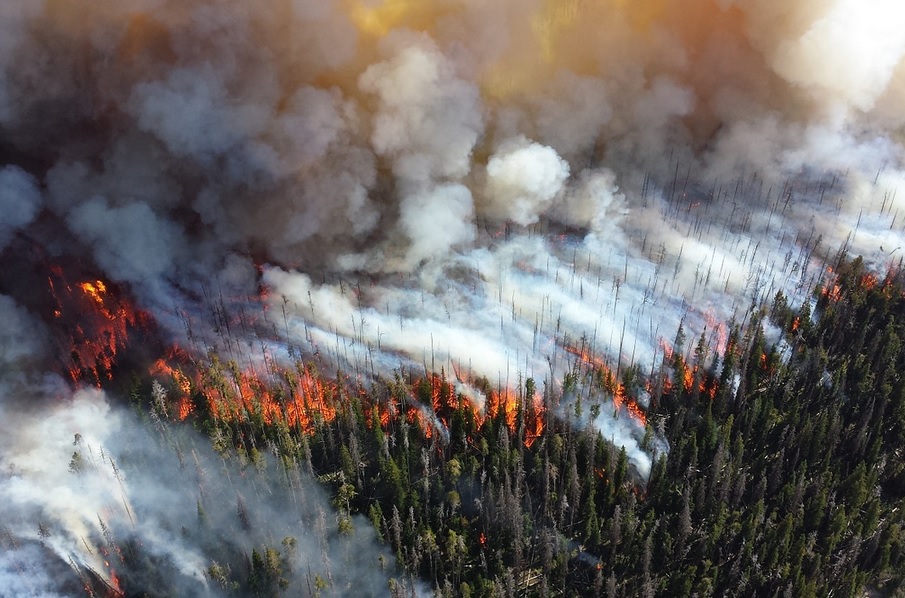
By Oregon State Representative E. Werner Reschke,
It’s summer. It’s hot in late July. It’s also fire season.
Growing up in Oregon, that last statement is relatively new, until about 10 years ago. Large forest fires in Oregon’s previous history were infrequent. By one count, between 1902 and 2002, there were about 10 large forest fires in Oregon. But since 2002, that number is closer to 40. Recent summers show several large fires burning out of control that destroy homes and property, leaving behind a scarred and ugly landscape. These fires also endanger air quality for many. This year is no different with the Flat Fire in Curry County and the Bedrock Fire in Lane County burning away Oregon’s beautiful landscape.
Critical question: Why has there been an increased frequency in large, destructive forest fires? “Why?” is the correct question we should be asking. I learned long ago that the improper diagnosis of a problem almost certainly leads to the wrong solution.
One Answer: Climate Change
Experts confidently step forward with the answer that it is climate change that causes forest fires — people driven climate change. Their opinion is that Oregonians need to stop using fossil fuels, to reduce CO2 in the atmosphere. Fewer CO2 emissions would then cool the climate, which would then lead to fewer forest fires. Even if all of those assertions were true, it is doubtful that Oregonians could do much to affect global CO2 amounts in the world atmosphere, let alone effect the temperature. Oregon accounts for roughly 0.13% (0.0013) of the human-generated CO2 in the atmosphere. By comparison China contributes about 27% (over 200 times more). In addition, human-generated CO2 accounts for roughly 5% of all CO2 in the atmosphere. The remaining 95% comes from natural sources, such as plants and the ocean.
During a Carbon Reduction committee meeting in 2018*, the lead state climatologist claimed that if Oregon went to “net-zero” (meaning Oregon were to offset all of our CO2 output with more trees and things that absorbed CO2 from the atmosphere), that Oregon’s contribution to global temperature would be “imperceptible.” Even if Oregon could miraculously become CO2 neutral, it wouldn’t do much of anything except drive up the costs of transportation and energy, while making both less reliable — which is happening now in 2023.
Another part of the Climate Change solution is to spend hundreds of millions on building a bureaucracy to fight forest fires. Spending money shows action; it shows care and compassion. However, without properly diagnosing the root cause for the increased frequency and size of forest fires, this bureaucratic spending does little to actually help prevent large forest fires. Sure, we need an appropriate response to fight forest fires — and I am thankful for the brave, frontline people dedicated to this task — however, we also need to be at the front end of this problem, to focus on prevention. At the very least make these fires less frequent and less intense when they do occur.
Another Answer: Improper Forestry Practices
Since the advent of the spotted owl in the late 1980’s, forestry practices at the federal and state level have changed dramatically. Over 50% of the land mass in Oregon, including a large portion of forest land, is owned and operated by the Federal & State governments. What Washington DC and Salem decide about forestry deeply impacts Oregonians. Since the late 1980’s, the logging of public forests has dropped tremendously. While private foresters do a noble job managing their forests, government agencies have taken a different approach. If you ask any responsible forester for an honest assessment about the condition of our public forests, you’ll quickly learn, especially in most public forests in Oregon, there are far too many trees in too close proximity to one another. In essence, the public policy for the last 30 years has been “let it go natural”. This has created a tinder box that quickly goes up in flames from a single spark whether caused by nature or people.
We are now experiencing this problem because a forest takes at least 20-30 years to get to a point where the fuel load is ready to explode. The “letting it go natural” strategy has led to public forests which are far too dense and overgrown underbrush that are optimal for large fires. There is a saying about forests: log them, graze them or watch them burn. Until the spotted owl, logging and properly managing forests was our policy at the federal and state level. During my first 40 years of life I can’t remember one news story or one smokey day because of a forest fire in Oregon. Since then, I grow concerned what each summer will bring.
Addressing The Root Cause
In my last newsletter, “There’s a Hole in the Boat!” I stressed the state needs to address problems at the front-end, by tackling the real causes, instead of only working on back-end “solutions” that continually mop-up or sweep-over the messes created. Whether it’s homelessness, or forest fires, the principle is the same: we must not be duped by the smoke screen of leftist political rhetoric, but properly diagnose and address the problem head on. It is foolish to expect more solar panels, wind turbines and electric cars to quell large forest fires in Oregon. The real answer is proper stewardship of public forests by reducing forest fuel loads.
Until State and Federal governments take the right action to address the root cause of large and frequent forest fires, Oregon’s foreseeable destiny will be to chase its tail, while needlessly allowing Oregonian homes, lives and property to go up in toxic, unbreathable smoke.
(file photo)
Disclaimer: Articles featured on Oregon Report are the creation, responsibility and opinion of the authoring individual or organization which is featured at the top of every article.

